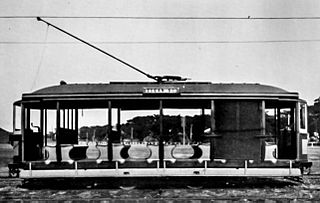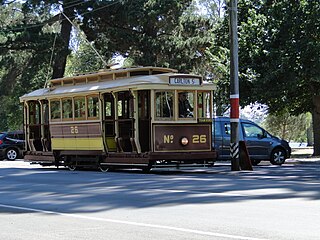
The Sydney tramway network served the inner suburbs of Sydney, Australia, from 1879 until 1961. In its heyday, it was the largest in Australia, the second largest in the Commonwealth of Nations, and one of the largest in the world. The network was heavily worked, with about 1,600 cars in service at any one time at its peak during the 1930s . Patronage peaked in 1945 at 405 million passenger journeys. Its maximum street trackage totalled 291 km in 1923.

A double-decker tram or double-deck tram is a tram that has two levels or decks. Some double-decker trams have open tops. Double-deck trams were once popular in some European cities, like Berlin and London, throughout the British Empire countries in the early half of the 20th century including Auckland, Christchurch and Wellington in New Zealand; Hobart, Tasmania in Australia and in parts of Asia. They are still in service or even newly introduced in Hong Kong, Alexandria, Oranjestad, Blackpool, Birkenhead, Franschhoek, Auckland and Douglas, mostly as heritage or tourist trams.

The earliest trams in Australia operated in the latter decades of the 19th century, hauled by horses or "steam tram motors". At the turn of the 20th century, propulsion almost universally turned to electrification, although cable trams lingered in Melbourne. In cities and towns that had trams, they were a major part of public transport assets.

The O-class trams were a class of trams operated on the Sydney tram network.

The P-class trams were a class of trams operated on the Sydney tram network.

The R1-class trams were a class of trams operated on the Sydney tram network. Their design was a development of the R class.

The C-class trams were a class of single bogie end-loading electric trams operated on the Sydney tram network.

The R-class trams were a class of drop-centre saloon car type trams operated on the Sydney tram network.

The D-class trams were a class of single bogie Californian Combination type trams operated on the Sydney tram network with open cross benches at the ends and a saloon in the centre.

The Sydney Steam Motor Trams were built for and operated by the New South Wales Government Tramways of Australia.

The E-class trams were a class of single bogie (four-wheel) single-ended cross-bench design trams operated on the Sydney tram network. They always operated in permanently-coupled pairs because they were fitted-out electrically as if the pair was a single bogie car.

The F-class trams were a class of two-bogie California combination car trams operated on the Sydney tram network with longitudinal seating in the open part of the car. They were later rebuilt as the L-class trams and some again as the L/P-class trams.

The Sydney G-class Trams were a class of single ended cars were designed to operate either permanently coupled back to back in pairs or singly hauling a trailer on lines with reversing arrangements at the terminii.

The H-class trams were purpose built single truck, open cross bench cars built at Randwick Tramway Workshops as tourist cars for the City - Bondi Beach/Coogee and City - La Perouse/Botany services.

The J-class trams were built as replacements for the King Street to Ocean Street, Edgecliff cable line designed to provide a frequent schedule, but with a lower seating capacity. Some briefly operated on the Manly lines in 1911. Withdrawals commenced in 1934 with the entry of the R Class trams, with all out of service by 1936.

The M-class trams were built by the Randwick Tramway Workshops for use on tourist services on the Sydney tram network to replace two modified G class trams. Originally allocated to Fort Macquarie Tram Depot, they later moved to Newtown and again to Ultimo before being scrapped in 1941.

The N-class trams were a crossbench design of tram with a two-bogie design, each pair of benches had doors at each side.
Stortford Street electric railway station was the fourth of five calling points on the 1+1⁄4 miles (2.0 km) eastern, "street" section of the inter-urban Grimsby and Immingham Electric Railway when travelling from Corporation Bridge, Grimsby to Immingham Dock.

The M-class was a class of 17 trams built by Duncan & Fraser, Adelaide for the Hawthorn Tramways Trust (HTT) as numbers 1 to 10, and 33 to 39. All passed to the Melbourne & Metropolitan Tramways Board on 2 February 1920 when it took over the Municipal Tramway Trusts, becoming the M-class and being renumbered 107 to 116, and 183 to 189.

The P-class was a class of eight trams built by Duncan & Fraser, Adelaide for the Hawthorn Tramway Trust (HTT) as numbers 25 to 32. All passed to the Melbourne & Metropolitan Tramways Board on 2 February 1920 when it took over the HTT becoming the P-class and being renumbered 131 to 138.



















